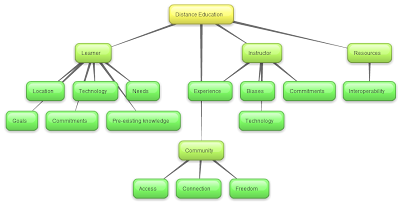 |
| The technological solution needs to consider a number of factors. |
1. The Scenario
2. The Requirement
3. The Assumptions
4. The Instructional Designer (ID)
5. Support for the ID (and the Solution
The Scenario: Asynchronous Training
In an effort to improve its poor safety record, a biodiesel manufacturing plant needs a series of safety training modules. These stand-alone modules must illustrate best practices on how to safely operate the many pieces of heavy machinery on the plant floor. The modules should involve step-by-step processes and the method of delivery needs to be available to all shifts at the plant. As well, the shift supervisors want to be sure the employees are engaged and can demonstrate their learning from the modules.
The Requirements:
As a starting point, let’s look at the requirements that this scenario needs to address:
1. Independent design of modules so they can stand-alone
2. Design which contains step-by-step processes
3. Continual availability so that training can be done by all shifts
4. Design that engages employees
5. Reporting that will demonstrate that learning has occurred
The Assumptions:
With the requirements down, the ID needs to ask some questions about the technology available at the delivery point. From these answers, come assumptions which will serve as parameters for the technology that can be used for creating the training modules. So, let’s say that the ID asked some further questions and discovered the following about the organization and delivery environments that were available:
1. The organization does not have any existing Learning Management System (LMS) or Learning Content Management System (LCMS). A LMS will need to be considered in the solution, as the focus will be on individuals and tracking individual needs and learning outcomes over time (Simonson, Smaldino, Albright & Zvacek, 2009).
2. The organization does not have the internal ability to support these modules technically and is not open to purchasing or installing a LMS or LCMS that they will need to maintain.
3. Web-enabled, high-speed terminals are available at each work-station within the plant with audio capabilities.
4. The organization is not able to support additional follow-up with subject matter experts. The modules truly need to be self-contained without any expectation of instructor or subject matter expert interaction with learners.
These assumptions need to be considered into the technology choices as well.
The ID:
The technological assumptions help to narrow down the choices. The technological capabilities of the ID need to be considered, as well as the budget for the project. So, let’s say that the ID has skill adequate enough to use video, audio and image editing software to support the development of the modules and has adequate skills to use a basic “What you see is what you get” (WYSIWYG) development environment, but not enough budget to develop highly complex and customized interactivity using a tool such as Flash. The ID also does not have significant technological skill in terms of determining interoperability issues that may arise related to integrating the modules with the LMS (and there is no technical back-up from the organization to deal with this either).
The Solution:
With all of these requirements, assumptions and parameters in mind, the ID sets out to find a set of technological solutions that meets all of the criteria. The criteria that poses the greatest challenge in this situation, is the need for LMS tracking functionality without having the ability or technological support to house the LMS internally. This eliminates some of the alternatives available that seamlessly allow the ID to create modules and publish them to a LMS (i.e. Lectora Products).
What the ID ultimately proposes in this scenario is:
a) Stand-alone modules developed using the Articulate Studio (which includes Articulate Presenter, Engage for creating step-by-step scenarios, and Quizmaker for creating evaluations to measure learning)
b) LMS tracking and reporting capabilities supported through Articulate Online (which is designed to support delivery of the Articulate modules).
The Support:
References:
Articulate: www.articulate.com
Simonson, M., Smaldino, S., Albright, M., & Zvacek, S. (2009). Teaching and learning at a
distance: Foundations of distance education (4th ed.) Boston, MA: Pearson.
